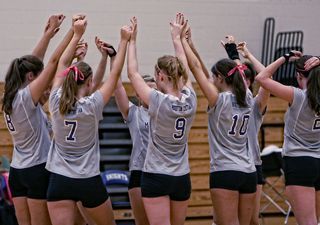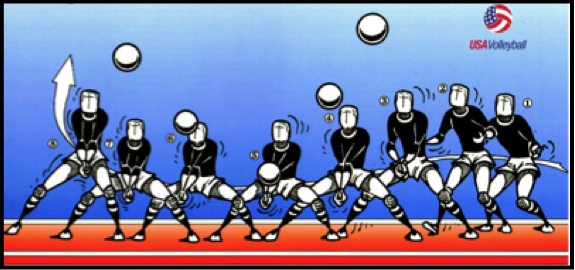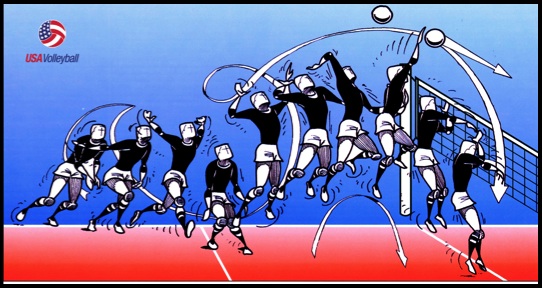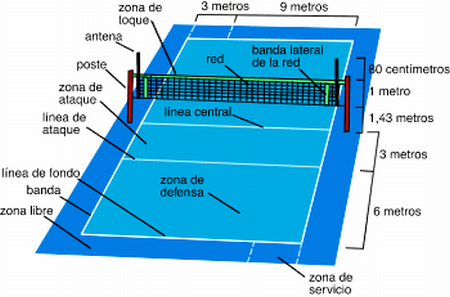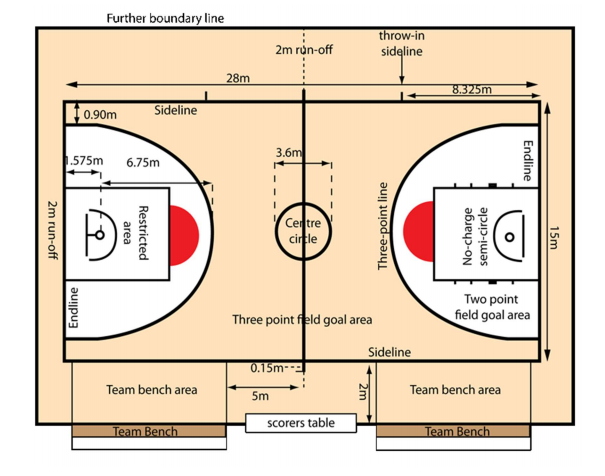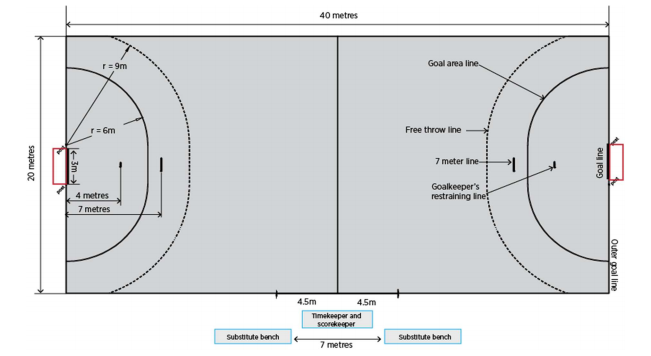Sitio web de Remigio Pérez Physical Education in Bilingual Proyects
TEAM SPORTS
-VOLEY
-BASKET
-HANDBALL
TEAM SPORTS
VOLEY
VOLLEYBALL History
In 1895, William G. Morgan invented a new game called "Mintonette". However, when an observer named Alfred Halstead saw the game being played, he noticed the volleying action used to get the ball over the net, so he decided to change the name to "volleyball". Morgan wanted to create a skilled activity, which required more players, less space, and less exertion than basketball. The first net was a “rope” and the first ball was a basketball air bladder. Until 1960, men and women played with different rules. Now the rules are the same except for the height of the net, the men’s net is higher.
WHAT´S A VOLLEYBALL GAME LIKE?
Volleyball players hit a ball over a net using any part of their bodies. You score a point when the opponent team is either unable to return the volleyball over the net or prevent it from touching the court surface. You don' t need to have the possession of the ball to score. Who wins? The first team to score 25 points by a margin of two points, wins the set. The team that wins three sets wins the volleyball match. How Long Is A Match? There is no set time limit for a volleyball match. There are two-minute breaks between each game; teams switch court sides after each break. Team captains flip a coin to determine which side will serve first. What are the main faults? -The ball is held, thrown or pushed. -A team contacts the ball more than three times consecutively. Except when the first contact is a block. -A ball touches a player twice in succession or the ball touches the body twice in succesion. -Players are out of position at service. -A player enters a non-playing area to play the ball. -A player touches the net. -A player attacks the ball above the opponent´s court or steps in the opponent’s court. What you can do: -Touch the ball with any part of your body. -Hit the ball three times between different players. -Play the ball outside of the court lines. -Serve anywhere behind the base line. -Touch the net with the ball. What you can´t do: -Touch the ball two times consecutively -Hold the ball or push it -Touch the net with your body -Step on the centre line or the opponent´s court.
NOW LET´S START WITH THE VOCABULARY: TECHNIQUES: A Serve: Servicio o saque An Underhand serve: saque de abajo A Set/Overhand pass: Colocación o toque de dedos. A pass/Forearm pass /Dig: Toque de antebrazos A Spike or Smash: Remate A block: un bloqueo. A Rally: un punto, la duración de un punto
ACTIONS: To serve, to pass, to set... To attack: atacar To defend: defender To switch or rotate: rotar To hold: sujetar o mantener To score: anotar To hit: golpear To commit: cometer To place: colocar o poner To reach: alcanzar To lean: inclinarse To wrap: envolver To swing: balancear To raise: elevar To aim: apuntar
PLAYERS: Front row player: delantero Back row player: zaguero Server: sacador Captain: Capitán Hitter or spiker: rematador Libero: libero
A) THE UNDERHAND SERVE: The serve begins play, and it can be decisive in a game. A missed serve counts as a fault. There are many types: underhand, sidearm, or overhand motion to strike the ball, standing in a stationary position or jumping in the air. We will learn the basic one, the underhand service. -Stand outside the court, anywhere along and behind the end line. -If you are righthanded, hold the ball with your left hand. Place your left foot in front of you but behind the line. -Place the ball in front of your body, in line with your right foot and arm. Move your right arm back, keeping it straight. -Move your arm forwards to hit the ball, and keep it extended. If you bend it, the ball will not reach the net. -Hit the ball with the palm of your hand. If you do not hit the ball with a flat surface, its trajectory is unpredictible. -Keep your hand tense. It is not important if you close or you open your fingers, but you must hold them tense, so you don´t hurt yourself when hitting the ball. -After hitting the ball, follow it through with your body and step into the court. Here you have a couple of videos from www.expertvillage.com explaining the serve: The underhand serve: He says you can use your fist, but if you don´t hit it in the middle, the ball is going to go to one side. That´s why in our classes we always learn to serve with our palms. The overhand serve:
B) THE FOREARM PASS (OR DIG): Use it to receive a serve or a low ball. -Place your body low, extend your forearms and pass it up to the “setter.” -Position is fundamental to react quickly: Your feet must be shoulder width apart. You must wait for the ball leaning forwards on your toes with a semi-flexion of your knees. -Join your hands together, making a fist with one hand and wrapping in it the palm of your other hand. -Let the ball hit you in the middle part of your forearms simultaneously. A common mistake is to hit the ball with your wrists or hands. This often makes the ball bounce with an unpredictable trajectory and it goes out of your court. -Press the wrists and hands down to fully extend the arms -Bend your knees before the ball gets to you so that you can absorb the serve and keep the ball in your court.
C) THE SET: -The set is an overhead pass in which the setter directs the ball upward with a high arc to front-line players for them to spike. There are many different types of sets: to the front, to the side, to the back... -The proper technique for setting is to raise your hands about 15 cms above your head with your thumbs on the bottom. Your thumbs and index fingers must form a triangle, and also, your hands must form the shape of the ball. -Go to the ball and get under it, facing the direction to which you want to pass it. -Bend your elbows and your knees. -You must hit the ball with both hands together and simultaneously. Don’t let the ball touch your palm. This is called a push, and is a violation. If you hold the ball or you strike itl unevenly, you’ll be in violation. -Receive the ball over your head, and act as a spring. -All the following parts of your body must extend with the ball when you are doing a set: first your legs, afterwards your upper body and arms, and finally your wrists and fingers.
D) THE SPIKE (OR SMASH): -The spike is a powerful overhand smash into the opposite court. -The spiker steps toward the net, jumps high in the air, and swings his or her arm powerfully toward the ball to smash it. The spiker must be careful not to touch the net. -Front row players can attack the ball from anywhere on the court. Back row players can only attack from behind the three meter line. - Approach to the net and in the last step, place both feet at the same time on the floor. Your feet must be shoulder-width apart. Swing both arms back to help you with the jump. -Jump with both feet, as you aim to the ball with your left hand (if you are righthanded). -In the air, bring your right hand to your ear, and your elbow back. Bring your left arm down and hit the ball with your right palm. Your arm must be extended. -You must hit the ball infront of your head, not above it, so it goes straight to the floor. -Do not touch the net, and land on both feet. -This is a very difficult move, and requires perfect timing with the ball, so keep trying until you get it!! -Start practicing the timing and the jump with a partner holdeng the ball over the net.
E) THE BLOCK: The block is the first defensive action a team makes. It can be individual, double or triple. -If you do it correctly, you make an opponent´s strike rebound on your hands and it will either go to his side of the court or to yours, but at a slower speed. There are a couple of things to remember: -The block does not count as a hit, so a player can block a ball and still hit it with a forearm pass or a set. -You must not touch the net, and you must be sure not to hit the ball twice! -To do a good block, you must stay close to the net to be able to react quickly. -Your arms, hands and fingers must be fully extended above the shoulders. -Pay attention to the hitter in front of you and move to be in front of the ball when it descends to him or her. -You must jump slightly later than the hitter. -As you jump, fully extend your arms and hands. Spread your fingers, but keep them rigid. Bend your wrists down over the net, so that if the ball hits them, it goes down to the floor. Positions: There are six positions in the court. Three in the front line and three in the back line. Players must keep their positions before the other team serves.
After the server hits the ball, players can move freely. Positions are numbered 1 to 6. number 1 is the serving position, ar the right side of the back line. Number 2 is in front of him, to the right of the front line. The rest of the positions are numbered counterclockwise, so number 6 is the back line player on the centre. The Server - Stands with both feet in the “service area”: behind the baseline of the volleyball court. One player serves continuously until his or her team commits a “fault”, after which the opposite team “rotates” and serves the ball. The Libero The libero is a defensive specialist. This player typically wears the same jersey as the team but ina in an opposite color. He or she usually plays in position numer 6. It has special substitution privileges and is preferred to receive the oposing team´s hits or spikes. Back-row Players (Left, Right, Middle Backs) Front-line Players (Left, Right, Middle) - Play in the backcourt behind the attack line. -They are responsible for passing the ball towards teammates who then “set” the ball to the spikers. -Back-row players also “dig” the ball on returned shots. -Positioned in the frontcourt between the attack line and the net. -These players mostly hit “spikes” into the opposite court and jump to “block” shots hit by the opposing side. Rotation: Everytime your team gains the posession of the ball, your whole team must rotate one position clockwise. So the player that was in position number 2 goes to position number 1 and serves. Player that was on number one moves to number 6 and so on. Each player must be within the court at the time the ball is served. All players must be in their correctly rotated position. If one player is out of his position, the team commits a fault and they lose a rally.
BASKETBALL
BASKETBALL
A) BASIC VOCABULARY: Actions: To bounce: botar To dribble: botar avanzando To pass: pasar To shoot: tirar To slam: machacar To defend: defender To attack: atacar To score: anotar Elements of the game: The ball: la pelota The court: la cancha The hoop: el aro The backboard: el tablero The lines: las líneas The key: la zona A tie: un empate Fouls and violations: Personal foul: falta personal Offensive foul: falta en ataque Technical foul: falta técnica Traveling: pasos Double dribble: dobles 3/5/8/24 seconds violation: infracción de 3/5/8/24 segundos. Basketball is a team sport in which two teams of five players, opposing one another on a rectangular court, compete with the primary objective of shooting a basketball (approximately 9.4 inches (24 cm) in diameter) through the defender's hoop (a basket 18 inches (46 cm) in diameter mounted 10 feet (3.048 m) high to a backboard at each end of the court) while preventing the opposing team from shooting through their own hoop. A field goal is worth two points, unless made from behind the three-point line, when it is worth three. After a foul, timed play stops and the player fouled or designated to shoot a technical foul is given one or more one-point free throws. The team with the most points at the end of the game wins, but if regulation play expires with the score tied, an additional period of play (overtime) is mandated. Players advance the ball by bouncing it while walking or running (dribbling) or by passing it to a teammate, both of which require considerable skill. On offense, players may use a variety of shots—the lay-up, the jump shot, or a dunk; on defense, they may steal the ball from a dribbler, intercept passes, or block shots; either offense or defense may collect a rebound, that is, a missed shot that bounces from rim or backboard. It is a violation to lift or drag one's pivot foot without dribbling the ball, to carry it, or to hold the ball with both hands then resume dribbling.
B) BASIC RULES: - Basketball players play with a ball on a court dribbling, passing, and shooting. -There are two teams of twelve players, five on the court. -They score points when a player shoots the ball through the hoop. -A basket (or field goal) counts two or three points, and free throws count one point each. -A basketball game has four quarters. -The length of each quarter has 10 minutes (12 in the NBA). -Play starts with a “jump ball” at center court. At halftime, teams switch sides. -Each team has 5 time of time-outs per game (6 in the NBA). If a game ends in a tie, teams usually play overtime periods until one team wins.
C) THE COURT AND BASIC PLAYERS´ POSITIONS: -Each player is assigned a position when playing. This position is usually determined by the height of the player. -NBA teams usually have: two guards, two forwards, and one center. -The tallest person usually plays “center”, while the medium size ones play “forwards”. -The shortest players then play “guards”.
D) VIOLATIONS: -A violation occurs when the player infracts the rules of Basketball. -A violation results in the awarding of the ball to the opponents. -It happens when the player takes more than two steps without bouncing the ball on the floor. This is called Travelling. -Another violation is when a player stops dribbling and then starts dribbling again or bounces the ball with its two hands at once. We call this a Double Dribble. -You can also commit a violation if you twist your hand , when in contact with the ball, pass the vertical. This is called Carry, as the hand must always remain on the top of the ball. -This is the first thing to learn.
E) THE DRIBBLING: The dribble is a push-pull movement of the arm. -Your fingers must form a cup to adapt to the ball. Fingers and wrist must be relaxed. - As the ball bounces back up, meet it with your fingers. Control the ball with your fingers, not the palms.
F) THE PASS: Two-Handed Chest Pass: Fundamentals: -Place each hand on either side of the ball and spread the fingers evenly. -Fully extend your arms as you push the ball out from your chest. -Be sure the pass is thrown with enough strength, with the ball parallel with the floor. -You want the pass to arrive at your receiver above the waist and below the shoulders. Two-Handed Bounce Pass: This type of pass is good to miss the defender´s hands, but it is the slowest one. -Use the same grip and motion with this basketball pass as you did with the chest pass. -The ball must hit the floor about two-thirds of the way to the receiver. Two-Handed Overhead Pass: This type of pass is easy to control and helps you keep the ball away from your defender. -Position your hands on the sides of the ball with your fingers pointed up. Your thumbs should be on the back of the ball and pointing in toward one another. -Bring the ball up above your head (be sure your hands go straight up, not up and back over your head). -It's usually good to make a step forward with the foot of your strong arm side when you throw the ball. Baseball Pass: Effective for long passes. - Place the ball high above the side of your head with the passing hand behind the ball while the other hand is in front of and slightly under the ball. -Plant your rear foot and step toward the receiver with your front foot. Try to keep both hands on the ball as long as possible and throw the ball with a quick wrist snap and arm thrust.
G) THE SHOOT: Basic position: -Your feet should be shoulder width apart with. Weight should be slightly forward on your toes, knees bent slightly, hips relaxed. -If you're right-handed, place your right foot slightly ahead of the left (if left-handed, place your left foot slightly ahead of the right). A good basketball shooting starts with the correct balance and your power for the shot comes from the legs, not arms.
H) THE LAY-UP: -Pick the side you are going to shoot from, right or left. Dribble the ball towards the basket with the hand of the side you are on. -When you get to the three point line, have the opposite foot in front of the side you're shooting from. Put the ball in the hand opposite the foot in front. -Run two giant steps towards the basket you're shooting at. About 1.5m from the basket, stop dribbling and jump off the foot closest to the basket. As you jump, your other knee should come up towards your chest. -Throw your ball at the backboard top corner with the hand furthest from the basket (right hand when approaching the right side of the basket; left hand when approaching the left side). The ball should hit the backboard and pass through the net.
I) THE UNDERHAND LAY-UP: -If you are right-handed, approach the basket from the right side. -You must jump off the foot opposite your shooting hand (in this case, the left) and bring your right leg, hand and arm up at the same time. -The left hand is used to protect the ball. -Keep the ball close to your body on the way up. -Your shooting hand should be in front of and under the ball with the fingers pointed up. -You should release the ball with a slight flick of your wrist, fingers and elbow at the peak of your jump.
BASKET COURT
HANDBALL
Handball is a team sport in which two teams of seven players each (six outfield players and a goalkeeper) pass a ball using their hands with the aim of throwing it into the goal of the other team. A standard match consists of two periods of 30 minutes, and the team that scores the most goals wins. There is no protective equipment worn while playingHandball is played on a court of 40 by 20 metres (131 by 66 ft), with a goal in the middle of each end. The goals are surrounded by a 6-meter (20 ft) zone where only the defending goalkeeper is allowed; goals must be scored by throwing the ball from outside the zone or while "diving" into it. Origins and development There is evidence of ancient Roman women playing a version of handball called expulsim ludere. There are records of handball-like games in medieval France, and among the Inuit in Greenland, in the Middle Ages. By the 19th century, there existed similar games of håndbold from Denmark, házená in the Czech Republic, handbol in Ukraine, and torball in Germany. The team handball game of today was codified at the end of the 19th century in northern Europe: primarily in Denmark, Germany, Norwayand Sweden.
Rules
Two teams of seven players (six field players plus one goalkeeper) take the field and attempt to score points by putting the game ball into the opposing team's goal.
In handling the ball, players are subject to the following restrictions: After receiving the ball, players can pass, keep possession, or shoot the ball. If possessing the ball, players must dribble (similar to a basketball dribble), or can take up to three steps for up to three seconds at a time without dribbling. No attacking or defending players other than the defending goalkeeper are allowed to touch the floor of the goal area (within six metres of the goal). A shot or pass in the goal area is valid if completed before touching the floor. Goalkeepers are allowed outside the goal area, but are not allowed to cross the goal area boundary with the ball in their hands. The ball may not be passed back to the goalkeeper when they are positioned in the goal area.
Playing field Handball is played on a court 40 by 20 metres (131 ft × 66 ft), with a goal in the centre of each end. The goals are surrounded by a near-semicircular area, called the zone or the crease, defined by a line six meters from the goal. A dashed near-semicircular line nine metres from the goal marks the free-throw line. Each line on the court is part of the area it encompasses.
GOAL The goals are two meters high and three meters wide. Duration A standard match for all teams has two 30-minute halves with a 15-minute halftime break. it ends in a draw after regular time, there are at maximum two overtimes, each consisting of two straight 5-minute periods with a one-minute break in between. Should these not decide the game either, the winning team is determined in a penalty shootout (best-of-five rounds; if still tied, extra rounds afterwards until won by one team).
The referees may call timeout according to their sole discretion; typical reasons are injuries, suspensions, or court cleaning. Penalty throws should trigger a timeout only for lengthy delays, such as a change of the goalkeeper. 3 team timeouts per game (up to two per half) Team players, substitutes Each team consists of seven players on court and seven substitute players on the bench. One player on the court must be the designated goalkeeper, differing in his clothing from the rest of the field players.
Substitution of players can be done in any number and at any time during game play. An exchange takes place over the substitution line. Field players Field players are allowed to touch the ball with any part of their bodies above and including the knee. As in several other team sports, a distinction is made between catching and dribbling. A player who is in possession of the ball may stand stationary for only three seconds, and may take only three steps. Goalkeeper Only the goalkeepers are allowed to move freely The ball is spherical and must be made either of leather or a synthetic material. It is not allowed to have a shiny or slippery surface. As the ball is intended to be operated by a single hand, its official sizes vary depending on age and gender of the participating teams. Awarded throws The referees may award a special throw to a team. This usually happens after certain events such as scored goals, off-court balls, turnovers and timeouts. All of these special throws require the thrower to obtain a certain position, and pose restrictions on the positions of all other players. Sometimes the execution must wait for a whistle blow by the referee. Throw-off A throw-off takes place from the center of the court.
The thrower must touch the middle line with one foot, and all the other offensive players must stay in their half until the referee restarts the game. Throw-in The team which did not touch the ball last is awarded a throw-in when the ball fully crosses the side line or touches the ceiling. If the ball crosses the outer goal line, a throw-in is awarded only if the defending field players touched the ball last.
Execution requires the thrower to place one foot on the nearest outer line to the cause. All defending players must keep a distance of three metres (9.8 ft). However, they are allowed to stand immediately outside their own goal area even when the distance is less than three meters. Goalkeeper-throw If the ball crosses the outer goal line without interference from the defending team or when deflected by the defending team's goalkeeper, or when the attacking team violates the Dzone as described above, a goalkeeper-throw is awarded to the defending team. This is the most common turnover.
The goalkeeper resumes the play with a throw from anywhere within the goal area. Free-throw A free-throw restarts the play after an interruption by the referees. It takes places from the spot where the interruption was caused, as long as this spot is outside of the free-throw line of the opposing team. In the latter case, the throw is deferred to the nearest spot on the free-throw line. Seven-meter throw A seven-meter throw is awarded when a clear chance of scoring is illegally prevented Penalties Penalties are given to players, in progressive format, for fouls thatrequire more punishment than just a free-throw.
Actions directed mainly at the opponent and not the ball (such as reaching around, holding, pushing, tripping, and jumping into opponent) as well as contact from the side, from behind a player or impeding the opponent's counterattack are all considered illegal and are subject to penalty. Any infraction that prevents a clear scoring opportunity will result in a seven-meter penalty shot. Typically the referee will give a warning yellow card for an illegal action; but, if the contact was particularly dangerous, like striking the opponent in the head, neck or throat, the referee can forego the warning for an immediate two-minute suspension. A player can get only one warning before receiving a two-minute suspension Offense (counter-attack) Left and right wingman.These typically are fast players who excel at ball control and wide jumps from the outside of the goal perimeter in order to get into a better shooting angle at the goal. Teams usually try to occupy the left position with a right-handed player and vice versa. Left and right backcourt. Goal attempts by these players are typically made by jumping high and shooting over the defenders. Thus, it is usually advantageous to have tall players with a powerful shot for these positions. Centre backcourt. A player with experience is preferred on this position who acts as playmaker and the handball equivalent of a basketball point guard. Pivot (left and right, if applicable). This player tends to intermingle with the defence, setting picks and attempting to disrupt the defence's formation. This positions requires the least jumping skills; but ball control and physical strength are an advantage. If the attacking team does not make sufficient progress (eventually releasing a shot on goal), the referees can call passive play
Handball Court
Comentarios recientes
05.10 | 09:57
Buenas tardes, encantado de saludarte. Soy Jose
Quería escribirte porque me ha parecido interesante comentar contigo la posibilidad de que tu negocio aparezca cada mes en periódicos digitales como not
08.09 | 09:54
Hola. ¿Cómo estás? Soy Alberto del Departamento de Prensa. Muchas gracias por atenderme.
He pensado que podría interesarte cómo podemos hacer que tu empresa aparezca en más de 50 periódicos digitales
23.07 | 05:21
Hola. ¿Cómo estás? Soy Alberto del Departamento de Prensa. Muchas gracias por atenderme.
He pensado que podría interesarte cómo podemos hacer que tu empresa aparezca en más de 50 periódicos digitales
24.04 | 16:48
Buenas tardes Alberto, te puedes poner en contacto conmigo mediante el correo electrónico, no veo ningún problema en que aparezca en prensa digital. Un saludo
Compartir esta página

